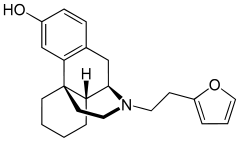Ro4-1539
 | |
| Identifiers | |
|---|---|
| |
| CAS Number | |
| PubChem CID | |
| Chemical and physical data | |
| Formula | C22H27NO2 |
| Molar mass | 337.454 g/mol |
| 3D model (JSmol) | |
| |
| (verify) | |
Ro4-1539 (Furethylnorlevorphanol) is an opioid analgesic drug from the morphinan series that was developed by the pharmaceutical company Hoffmann–La Roche in the 1950s.[1] It acts as a potent μ-opioid agonist, and was found to be around 30-60x more potent than the related drug levorphanol in animal experiments.[2][3] While it is notable for its high potency and therapeutic index (1100 in animal studies),[4] being among the more potent μ-agonist found in the morphinan series of drugs (though not on the scale of acetorphine and other morphinans in the extremity of their level of potency), Ro4-1539 had no particular clinical advantages over other available opioid drugs, and was never commercially marketed.
Ro4-1539 has never formally undergone clinical trials in humans, but based on its effects in animals it would be expected to produce effects similar to those of other potent opioid agonists, including strong analgesia, sedation, euphoria, constipation, itching, tachyphylaxis and respiratory depression, which could be harmful or fatal.
See also
- 14-Cinnamoyloxycodeinone
- 14-Phenylpropoxymetopon
- 7-PET
- N-Phenethylnormorphine
- N-Phenethyl-14-ethoxymetopon
- Phenomorphan
- RAM-378
References
- ↑ US 2970147, "3-hydroxy-N-(heterocyclic-ethyl)-morphinans", published 1961-01-31
- ↑ Nathan B. Eddy, Hedwig Besendorf and Béla Pellmont. Synthetic analgesics - Aralkyl substitution on nitrogen of morphinan. UNODC Bulletin on Narcotics 1958 p 23-42.
- ↑ Hellerbach J, Schnider O, Besendorf H, Pellmont B. Synthetic Analgesics. Part IIA. Morphinans. Pergamon Press, 1966.
- ↑ Bulletin on Narcotics October–December 1956 page 37